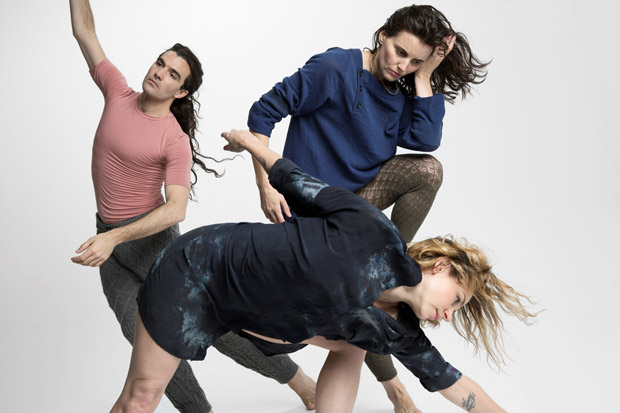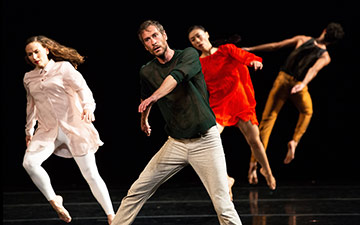
© Julieta Cervantes. (Click image for larger version)
NY Quadrille: Tere O’Connor Dance
Undersweet, Transcendental Daughter
★★★★✰
New York, The Joyce
4 October 2016
tereoconnordance.org
www.joyce.org
In the Round
The “NY Quadrille” experiment at the Joyce Theater, conceived and executed by the choreographer Lar Lubovitch, has turned out to be a success, at least in artistic terms. (That the theatre has not always been full is a separate, though not insignificant matter.) Lubovitch’s idea was to transform the conventional relationship between performer and viewer by creating a platform that extends the stage forward and placing seating behind it, creating a more “in the round” feel. (The quadrille was a French court dance, an antecedent of the Square Dance, executed in square formations.) This reorganization of the space, in turn, has affected the works being shown, banishing the conventional notion of “front,” and, more important perhaps, altering the experience of the people in the theatre. The audience on all sides is closer to the stage. And, because people can see each other, everyone feels in some way like a part of the action.
So far, I’ve seen two of the evenings, Pam Tanowitz’s Sequenzas in Quadrilles and Tere O’Connor’s double header Undersweet and Transcendental Daughter. The Tanowitz was an excellent primer of her craft: amazing intelligence in coordination of steps, an articulate sense of the body, and an exciting use of the dancers’ technique: jumping, turning, bending, balancing. As always her dancers were fabulous; they looked great in Reid Bartelme and Harriet Jung’s vibrantly-colored unitards. But her almost clinical approach to movement and structure undercut the work’s overall effect. It is as if Tanowitz were so fascinated by the steps themselves that she forgets about the larger arc of the dancing.
Tere O’Connor’s choreography, too, is fascinatingly specific, rigorously structured, intriguing in and of itself, but a bit impenetrable. The dancing is full of allusions, whose meaning is closed off to the audience. In this sense, Undersweet feels like a departure: a complete and gripping fusion of content and form. Eroticism and abstraction, inextricably combined. Two men, Silas Riener and Michael Ingle, engage in a breathlessly dynamic pas de deux, subdivided into sections by the music (excerpts from Jean-Baptiste Lully’s opera Atys). They saunter around the space holding hands, knees lifted; they engage in slow, gooey, and extreme partnering, à la Balanchine’s Agon; they crawl over each other, body to body; they converse in quick, elegant classical steps like the sissonne and the pas de chat. The dancing enters into a lively conversation with the rhythms and melodic gestures of Lully’s music.
The steps are conceived with Riener’s extraordinary physicality and technique in mind – Michael Ingle is very much the supporting partner. Riener is one of the most compelling performers in New York: completely focused and possessed of an uncanny efficiency and clarity of movement. His long hair and vivid presence bring to mind the young Mark Morris. The choreography shows off his line in a multitude of ways: low arabesques that gradually rise to relevé, slow unfoldings of the leg, small jumps, propulsive walks. It reflects O’Connor’s admiration for this specific dancer – here, the embodiment of eros – and for movement itself.
In fact, Undersweet was so compelling that its aura rather overshadowed the piece that followed, Transcendental Daughter, a gentle trio for Riener and two women (Eleanor Hullihan and Natalie Green). According to the program, the order was originally meant to be reversed, and it probably should have stayed that way. Transcendental reverted to a more familiar O’Connor style, with the dancers involved in highly specific, tightly-choreographed activities that defied a search for meaning or internal logic. The costumes, silky shifts and trousers by O’Connor, imbued the proceedings with a gently lyrical aura.
In a bluish light, to a soundscore that at times suggested rhythms and voices, the dancers riffed on the idea of the trio, forming lines, triangles, V’s, and clusters, seldom touching, but always working in tandem. The timing was impeccable, with all extraneous movement whittled away. And there were beautiful moments, like a slow revolution in which Riener gently held one woman’s leg in attitude and several graceful formations in which the dancers’ ankles crossed at center stage. The ending, in which Eleanor Hullihan advanced (or receded, depending on your point of view) with slowly undulating arms, was haunting. But the piece is a little meandering, and perhaps ten minutes too long.
Structure and meaning lie at the heart of O’Connor’s work. With Undersweet he has achieved a perfect balance.

















You must be logged in to post a comment.